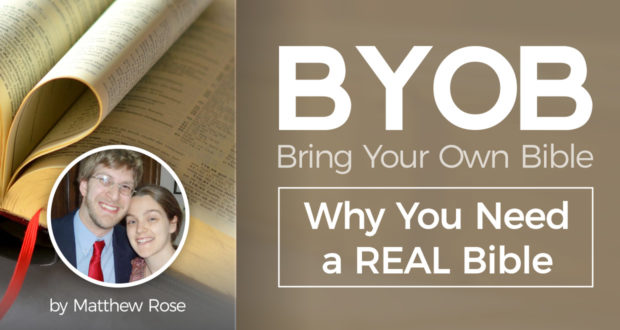Technology has revolutionized teaching and learning. To deny this is to deny the reality of a cultural shift which has transformed the relationship between teacher and student, parent and child, and family and school. It is no surprise, then, that many schools throughout the United States have adopted a BYOD program.
BYOD stands for Bring Your Own Device, meaning that students may bring their own personal electronic devices into the classroom for interactive activities. “Device” is used to describe any electronic device which can access the Internet.
Many would argue that this policy is important in training students to prepare themselves to interact in a rapidly-changing globalized world, but there is one item that a device should not replace: a Bible.
Lost in Quotation
True enough, several websites have interactive Bibles on them, wherein a student can search a passage of Scripture simply by typing in its citation. If a student needs to read John chapter 6, he can simply look up the passage through one of these websites, easily accessible through a device. He will find the passage he seeks, easily enough, and that is fine for finding a specific quote.
However, something is lost in translation from page to screen. Students whose reading of the Scriptures comes from a screen miss two major aspects of reading the Bible: the story of Salvation History and the journey with the Israelites to Christ.
Most online Bibles offer the bare text of the Scriptures, and rightly so, as that is what the website is programmed to do. When someone is seeking to quote a passage from the Bible, he is looking for the Bible’s text, the inspired words of God.
However, digital Bible readers often miss the comprehensive story in the Bible. Most Bibles include uninspired parts, namely, the footnotes and the cross-references. While some Bible footnotes might be lacking (to put it nicely) the traditional views of the Biblical stories, they are nevertheless useful tools for students who might not know, off the top of their heads, the details of what life was like in Ancient Israel or why it was weird that this king did that thing.
Footnotes, even horribly Modernist ones, do shed some light on some mysteries of the Bible. The historical context, though not necessary to our understanding of the Scriptures, does help us see how God works in Salvation History.
Likewise, the cross-references place a passage in the Bible within the rest of Scripture. One can see the thread of the story, so to speak. The reader of the sacred texts might connect a phrase used by a Gospel writer to its original source in the prophets. With both the footnotes and the cross-references, anyone can read the Bible as one book, drawing together the various threads which weave the Biblical story.
The ‘Different’ Book
Regarding the journey of the Scriptures, a student who exclusively uses a digital edition misses out on the spiritual adventure of a lifetime. When we flip through the Bible, we travel through Salvation History, a journey which is emphasized in turning the Bible’s pages. When we hunt for a particular passage or book, when we turn one page to another, we find the place of one book in the Bible in relation to the others.
We learn which event came first by seeing where the event’s book is in relation to the others. We see how the message of God through His prophets progressed from the pre-exilic voices to Malachi, the messenger of the “great and terrible day” of the Lord. We see the message of God morph for each generation, and finally, as we flip to the end, we see how the story culminates in the life and sacrifice of Christ. This journey is lost in digital editions of the Scripture.
There are, of course, great advantages to having access to a digital edition of the Bible. Not everyone carries a bound book of Scripture with him when he travels to work or the store or family gatherings. In the midst of a busy day, we often find chances to speak about Christ to our neighbor (whether we do that or not depends on the situation and our personality).
The subway-riding apologist makes great use of a digital Bible precisely because it is portable and easily accessible. That said, the digital Bible on an electronic device, while easy to access, does not necessarily aid in deepening one’s understanding of Scripture. It runs the risk of being another app, another story stored among the millions available at our fingertips.
In this digital age, we run the risk of losing the Word of God for the words on the screen.
Perhaps we should pause before having students use digital Bibles in class. Let the Scriptures be the one book they bring in their bag. Perhaps one day, all other course books will be on devices. Please, not the Bible.
Let it remain the different book. Perhaps having the weight of the Word in their hands will lead students to ask a simple question, reminiscent of the Passover dialogue: Why is this book different from all other books?
That question is our first step to friendship with God. Let’s not rob our children of that.

 Seton Magazine Catholic Homeschool Articles, Advice & Resources
Seton Magazine Catholic Homeschool Articles, Advice & Resources

